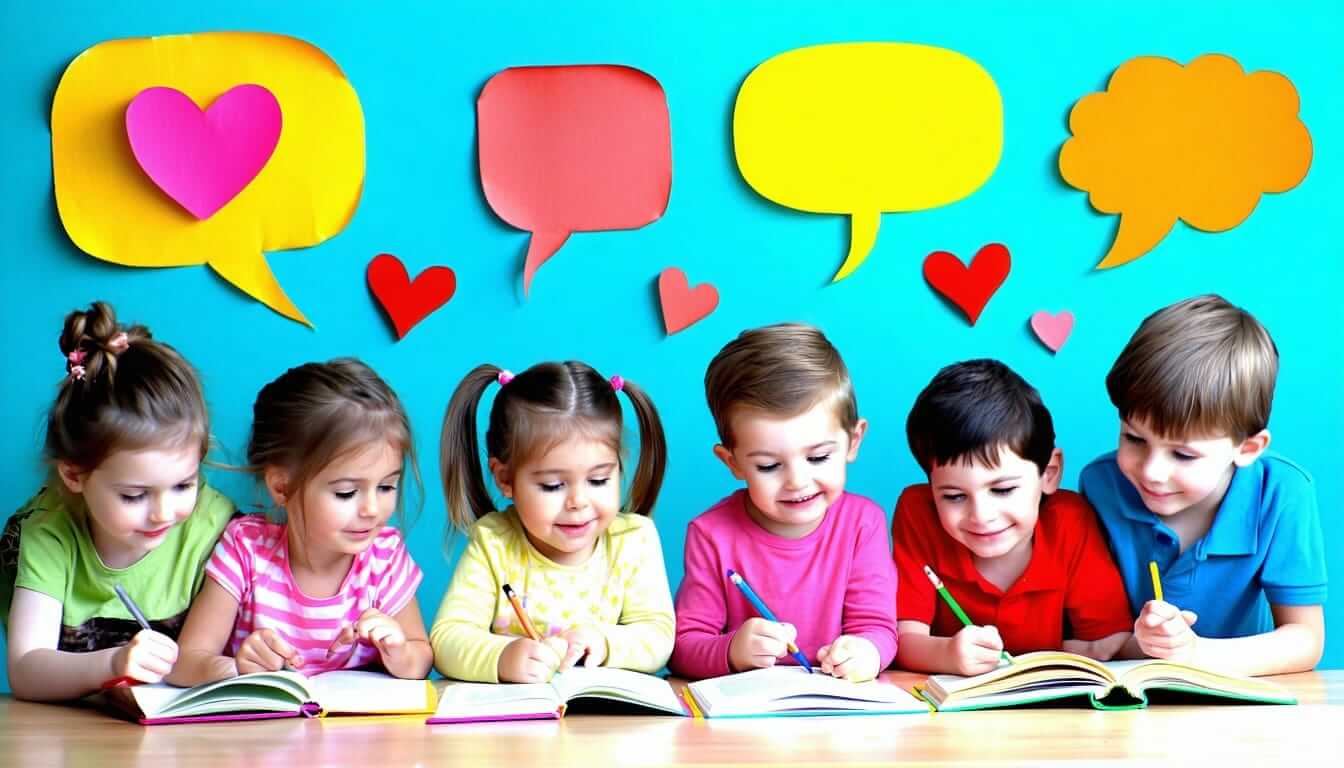Instilling Respectful Behavior
Teaching respect is a key part of raising a good kid, especially when they’re between 4 and 12. You’re the main example they see, and how you act around them can make or break their understanding of respect.
Modeling Respectful Interactions
Kids are like little sponges, soaking up everything they see. Show them how it’s done by treating people right. Toss in a few “pleases” and “thank yous” now and then, and you’re setting the stage for them to follow suit. This simple habit teaches them the ropes of polite interaction.
| Action | Description |
|---|---|
| Use Courteous Phrases | Sprinkle “please” and “thank you” into chats and exchanges. |
| Offer Help | Lend a hand to family or pals whenever you can. |
| Treat Others Well | Show a bit of empathy and patience in your dealings. |
Spending time with your kids, full of hugs, chats, and encouragement, boosts their sense of respect too. It’s not just about saying the right words but being there for them and showing kindness at every step.
Using Age-Appropriate Language
Breaking down respectful behavior into everyday language helps kids get it. Use words that match their age and make sense to their busy little lives.
| Age Group | Suggested Language Use |
|---|---|
| 4-6 Years | Simple stuff like “It’s cool to share with your friends.” |
| 7-9 Years | Talk about listening, give examples like “Listening means we care about others.” |
| 10-12 Years | Get into scenarios: “Respect means hearing out someone else’s opinion, even if you don’t agree.” |
By keeping these tips in your daily routine, respect just becomes part of who they are. And if you’re up for more ideas, check out teaching respect to children to find activities that help build their character.
Encouraging Respectful Behavior
Teaching your kids to be respectful is like giving them a ticket for a smooth ride through life. Here are two sure-fire ways to get respect lessons to stick with them.
Acknowledging Acts of Kindness
Spotting kind acts and giving them a high five can teach your kids about respect. When you notice and cheer on behaviors like sharing, taking turns, and helping others, you give a boost to those do-good habits. A little praise goes a long way in building a positive attitude and confidence. Experts say that recognizing kindness makes both home and school a more welcoming place (Honorable Character, Mental Health Center for Kids).
Try keeping a kindness chart. It’s a simple way to keep track of those golden moments. Here’s a quick plan for a kindness chart:
| Child’s Name | Kind Act | Date | Response |
|---|---|---|---|
| Emily | Shared her toy | 01/15/2023 | “Great job sharing, Emily! That’s super nice!” |
| Marco | Helped a friend | 01/16/2023 | “Well done, Marco! Helping is awesome!” |
| Lisa | Said ‘thank you’ | 01/17/2023 | “Awesome manners, Lisa! Keep it up!” |
This little chart can be a cheerleader, reminding your kids of their good deeds and encouraging them to keep it up.
Creating Visual Aids
Got a wall? Then you’ve got a stage for showing off respect! Use visual aids to help your child wrap their head around being respectful. Think charts, posters, and images that show everyday respect. A poster on the fridge—showing scenarios like listening to others or saying ‘please’ and ‘thank you’—keeps those respect goals right in their sights.
Create a “Respect Rules” board that sums up the basics with a splash of fun. How about something like this:
| Respect Rule | Image |
|---|---|
| Listen when someone talks | |
| Use polite words | |
| Share with buddies | |
| Help others |
Make it a team project to create these visual aids—it’s a blast and strengthens their grasp on the value of respect. Challenge them to think of times they can use these rules at home and with friends.
By making these strategies part of your routine, you build a home that oozes respect. Want more fun ideas to keep the respect ball rolling? Check out our respect activities for kids.
Promoting Respect Through Activities
Adding a bit of fun to teaching respect can make a world of difference. Feeling like a big kid isn’t just about age, it’s about understanding core values too. Let’s face it, games can be a great tool to shape the minds of kids aged 4 to 12.
Games for Learning Patience
Games with turn-taking can work wonders in teaching kids about patience and respecting others. Beloved classics like “Simon Says” or board games that have a wait-your-turn rule are perfect for this. They not only boast social skills but also teach the art of respectful chatting. During playtime, kids get to practice being patient in the best way—through fun! Feel free to explore here for more interactive ways to instill respect in kids.
| Game | What it Teaches | Suitable for Ages |
|---|---|---|
| Simon Says | Listening, following orders | 4-8 years |
| Uno | Taking turns, being patient | 7-12 years |
| Candy Land | Learning to wait your turn | 4-8 years |
| Duck Duck Goose | Team spirit, patience | 5-12 years |
These games not only reinforce lessons of respect but also keep the fun rolling in the learning process. Dive into our section on respect activities for kids for more creative ways to teach respect.
Teaching Respect for Authority
Respecting authority? Now, that’s a biggie. Encouraging humility and taking responsibility when dealing with authority figures like teachers or parents is a must. Instead of just obeying, kids should learn that it’s okay to question things—this nurtures their curiosity.
You can let them put on their drama hats with role-playing activities featuring authority figures. It’s a great way for them to voice their ideas while grasping why authority is important.
An engaging tool can be an anchor chart with images showing what respect looks like at home, in school, or out in the world. This visual guide helps them see why respect is key in any community. Teaching about respect for authority should go hand-in-hand with kindness and taking responsibility for one’s actions. Remember, showering praise on good behavior is like sunshine to a growing plant. For more ways to teach respect, hop over to our section on teaching respect to children.
Setting Examples for Respect
Building a solid base for respect starts with you stepping up as a parent and the principles you pass on to your kids. We’re going to focus on two big bits: how you act as a role model and why that old Golden Rule still matters.
Role of Parents as Role Models
You’re in the spotlight, folks! As a parent, you’ve got a front-row seat in influencing how your kids see and practice respect. When you walk the walk by showing respect in how you deal with folks, your kid picks up on that and wants to do the same. Like, sticking to rules, speaking kindly about others, and being polite—your kid’s going to notice and follow suit.
But if they catch you bad-mouthing the boss or breaking rules, that’s sending the wrong message about respecting authority. So, keep that respectful vibe going strong, it’s the best teacher out there (The Children’s Trust).
| Behavior Spot | Example Action | Kid Takeaway |
|---|---|---|
| Respect Vibes | Giving full attention | Encourages good listening |
| Not-so-nice Behavior | Shouting at others | Makes anger seem okay |
| Talk the Talk | Being kind with words | Teaches empathy and kindness |
Teaching the Golden Rule
The Golden Rule—treat others like you want to be treated—is big-time important for teaching respect. It’s a key lesson that helps kids get why empathy and thinking of others matter. By sharing this straightforward rule, you’re helping your kid grasp how their deeds impact those around them.
Bring the Golden Rule to life by weaving it into chats or through some role-playing games showing how it works in action. Push your kid to consider how they’d feel if they were on the receiving end. This light-bulb moment not only boosts their empathy but also sets a strong foundation for treating others right (The Children’s Trust). Want more tips on teaching respect? Drop by our page on respect activities for kids.
By living out respect and always championing the Golden Rule, you’re equipping your kids with crucial life skills to forge strong, respectful bonds.
Addressing Disrespectful Behavior
Teaching kids to respect others is like planting seeds of kindness that’ll grow over time. Now, when you hit a moment where those seeds don’t seem to be sprouting, it’s important to step in calmly and set things straight. This section’s got two key tricks up its sleeve: having consequences that are as solid as your morning coffee and chatting about what you expect.
Consistency in Consequences
When it comes to handling cheekiness, it’s like baking—stick to the recipe (or, in this case, the rules). Implementing consistent consequences teaches kids that actions have results. Handing out consequences without making kids feel small is like giving out spinach in a sweet smoothie; they learn what’s good for them without the bitterness. The Children’s Trust puts it simply: remain unwavering when dealing with bad behavior—it’s how children learn right from wrong.
You might want a go-to list of consequences that’s easy to follow. This can map behaviors to what follows after:
| Behavior | Consequence |
|---|---|
| Talking back | A pause from their favorite TV show |
| Ignoring chores | A day without gadgets |
| Being mean | Saying sorry to the person they’ve hurt |
Clear Communication of Expectations
Telling your little bean what you expect when it comes to respect is just as important as being consistent with the rules. Kids learn the difference between asking and arguing by watching you and other authority figures. Speak plainly and positively, so your kiddo gets it without scratching their head.
Chatting regularly about respect—maybe with a story or a fun example—helps make the lesson stick. When you spot a good deed, give that kiddo a high-five or shout-out to encourage more of that goodness. Being clear helps your child feel listened to and valued, making for a cozy, respectful home vibe (Raising Children Network).
Making time, perhaps at dinner or during a fun family activity, to chat about respect can work wonders. It’ll help make respect a normal part of life. And if you’re looking for more ways to sprinkle some respect-learning fun into your day, take a peek at respect activities for kids.
By practicing these two parenting gems, you’ll be setting up a home where respect is the norm – and maybe even a little fun, too.
Fostering Respectful Environments
Alright, let’s talk about the big deal—respect. Creating a respectful space isn’t just about being polite; it’s about giving your child’s social smarts a big ol’ boost. Let’s dive into a couple of must-have skills: empathy and handling arguments like a boss.
Encouraging Empathy
Empathy is like the secret sauce for getting along with others. It’s about teaching your kiddo to really get how others are feeling through face, voice, and action. The Mental Health Center for Kids agrees—being clued-in emotionally makes your child a better mascot for kindness and understanding.
Here’s how you can bump up that empathy game:
- Be the Role Model: You’ve got front-row seats to show empathy. Let them see you walking the walk.
- Chat About Feelings: Next time you’re reading a book or watching something, ask what the characters might be feeling. It’s like emotional detective work!
- Think Like Someone Else: Challenge your child to step into someone else’s shoes and guess how they might feel or what they could need.
These empathy exercises don’t just make your child a good friend; they boost those playground connections. Dive into our fun respect activities for kids for more of this good stuff.
Conflict Resolution Skills
Want your kid to handle spats like a pro? Teaching them to resolve conflicts gives them a tool to spin arguments into smooth-sailing talks. It also fine-tunes their respect radar in all their relationships.
Here’s your playbook for conflict resolution:
- Pinpoint the Problem: Show them how to put words to the snag without getting personal or finger-pointy.
- Keep the Conversation Flowing: Encourage them to put feelings into words and really listen to the other side. It’s all about understanding that there are two sides to every coin.
- Get Creative Together: Work with them to cook up solutions. Weigh the good and the bad with each idea, nudging them towards team-based problem-solving.
- Find Common Ground: Guide them in landing on a win-win solution, reinforcing that solutions mean everyone gives a little.
With these strategies, not only will your child look like a champ handling issues, but they’ll also help make home and school a more chill place. By sticking with these tips and expanding your efforts with our tips on teaching respect to children, you’re not just helping your child become a respectful superstar; you’re spreading a little mutual respect to everyone they meet.




